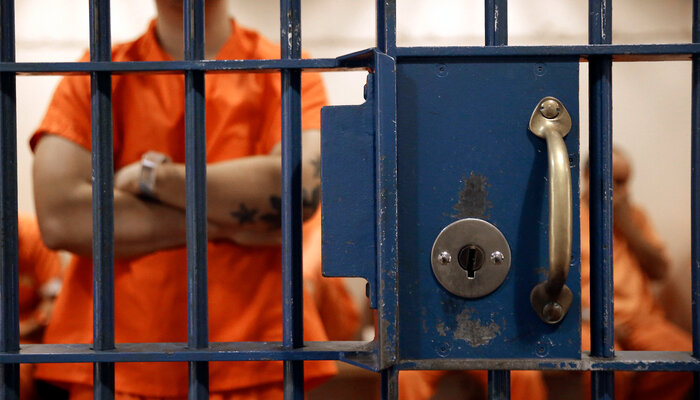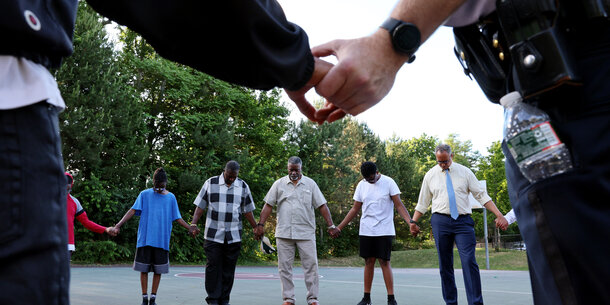Every day, judges set bail for thousands of individuals charged with a crime. Bail represents a promise that they will return to court for their next court appearance. In many cases, courts require that this promise be secured by money beyond people’s means. As a result, despite the presumption of innocence, thousands remain behind bars for months or even years until their cases are resolved.
Tying pretrial release to one’s ability to pay means that all too often wealth — not public safety, nor the likelihood of returning to court — determines who goes free and who awaits case resolution in jail. 1 Those without the means to post bail in cash can turn to third-party guarantees known as bonds, typically arranged by private bail bond companies that front the cost for a nonrefundable fee that can run into the thousands of dollars — a debilitating sum for many people. 2 This option may not be available for smaller but still-unaffordable bail amounts. 3
This system persists despite growing research on the harmful consequences of detention. Even a brief period in jail increases the risk that a person will lose employment and housing. Time in jail also increases the likelihood of future arrests. 4 This pattern could be due to the economic effects of incarceration (such as wage loss) or to disruptions to interpersonal relationships and community ties. 5 The threat of jail may even induce false guilty pleas, as some people would rather face a criminal record than spend additional time in pretrial detention. 6
The bail system contributes to the United States’ high rate of incarceration. An estimated two-thirds of the 750,000 people in the nation’s jails are awaiting resolution of their cases; as such, they are legally innocent. While some are detained because they have been deemed a threat to public safety or for another specific cause, most simply cannot afford to pay bail. 7 The number of people held in pretrial detention has risen sharply over time, multiplying by more than a factor of seven from 1970 to 2021. 8 The average amount of time spent in jail has also increased, from roughly two weeks in 1983 to nearly five weeks in 2021. 9
Over the past two decades, jurisdictions around the country have revised their policies on pretrial release, bail, and detention, drawing on broad and often bipartisan concern about the role of money in determining who goes free and who awaits trial in jail. 10 Despite progress, however, political backlash and implementation challenges have stymied reforms.
This report highlights recent examples of bail reform and the complicated dynamics that have prevented these policies from living up to their potential. Specifically, the report spotlights five jurisdictions that undertook major changes to bail policies through a variety of mechanisms, including legislation, litigation, and amendments to court rules. Three jurisdictions ultimately rolled reforms back in whole or in part; in the other two, reforms led to unintended increases in pretrial detention.
What happened? Lawmakers often made bail reform a scapegoat for rising crime rates, particularly during the Covid-19 pandemic, which coincided with increases in violent crime. But rising crime is by no means limited to 2020, and bail reform has long been a wedge issue. Further, the difficulty of acquiring and studying criminal justice data has made it hard for policymakers to defend or explain the effects of bail reform policies. Finally, judges, prosecutors, and pretrial supervision agencies have sometimes failed to adapt to reforms, leading to confusion and surprising results, such as seemingly paradoxical increases in supervision and detention.
Only by understanding the shortcomings of past reform efforts can advocates begin to overcome the challenges inherent to building a more equitable and efficient pretrial justice system.
Endnotes
-
1
See Insha Rahman, “Undoing the Bail Myth: Pretrial Reforms to End Mass Incarceration,” Fordham Urban Law Journal 46, no. 4 (2019): 865, https://ir.lawnet.fordham.edu/ulj/vol46/iss4/2 (“It seems obvious that a wealthy person accused of the same conduct as a poor one is no more or less likely to be a danger to society, simply because the wealthy can pay for their freedom while the poor cannot.”). -
2
In one instance, an individual was charged a nonrefundable fee of $3,275 by the bond agent, an amount that spiraled to at least $5,450 with additional fines and fees. Jessica Silver-Greenberg and Shaila Dewan, “When Bail Feels Less Like Freedom, More Like Extortion,” New York Times, March 31, 2018, https://www.nytimes.com/2018/03/31/us/bail-bonds-extortion.html. -
3
The United States and the Philippines are the only two countries where commercial bail bond companies dominate the pretrial release system. If an individual is unable to afford the entirety of the bail bond, that person — or someone else on their behalf — can pay a nonrefundable fee to a bail bond company or agent, who then posts bail with the court. The fee is usually 10 to 20 percent of the total bail amount. Once the person shows up in court, the agent is refunded the entire amount from the court, but the fee paid to the agent is nonrefundable. Adam Liptak, “Illegal Globally, Bail for Profit Remains in U.S.,” New York Times, January 29, 2008, https://www.nytimes.com/2008/01/29/us/29bail.html; and Nick Pinto, “The Bail Trap,” New York Times, August 13, 2015, https://www.nytimes.com/2015/08/16/magazine/the-bail-trap.html. -
4
Léon Digard and Elizabeth Swavola, “Justice Denied: The Harmful and Lasting Effects of Pretrial Detention,” Vera Institute of Justice, April 2019, https://www.vera.org/downloads/publications/Justice-Denied-Evidence-Brief.pdf; and Megan T. Stevenson, “Distortion of Justice: How the Inability to Pay Bail Affects Case Outcomes,” Journal of Law, Economics, and Organization 34, no. 4 (November 2018): 516, 532, https://academic.oup.com/jleo/article/34/4/511/5100740. -
5
Paul Heaton, Sandra Mayson, and Megan Stevenson, “The Downstream Consequences of Misdemeanor Pretrial Detention,” Stanford Law Review 69, no. 3 (March 2017): 760, https://perma.cc/8BB38BPY; and Will Dobbie, Jacob Goldin, and Crystal S. Yang, “The Effects of Pretrial Detention on Conviction, Future Crime, and Employment: Evidence from Randomly Assigned Judges,” American Economic Review 108, no. 2 (February 2018): 235, https://pubs.aeaweb.org/doi/pdfplus/10.1257/aer.20161503. -
6
Digard and Swavola, “Justice Denied,” 4–6; and Ram Subramanian, Léon Digard, Melvin Washington II, and Stephanie Sorage, In the Shadows: A Review of the Research on Plea Bargaining, Vera Institute of Justice, September 2020, 11–15, https://www.vera.org/downloads/publications/in-the-shadows-plea-bargaining.pdf. -
7
U.S. Commission on Civil Rights, The Civil Rights Implications of Cash Bail, January 2022, https://www.usccr.gov/files/2022–01/USCCR-Bail-Reform-Report-01–20–22.pdf (“more than 60 percent of inmates are detained prior to trial due to an inability to afford posting bail”). -
8
Zhen Zeng, “Jail Inmates in 2021 — Statistical Tables,” Bureau of Justice Statistics, U.S. Department of Justice (DOJ), December 2022, 1, https://bjs.ojp.gov/sites/g/files/xyckuh236/files/media/document/ji21st.pdf (listing 2021’s midyear pretrial population as 636,300); and Digard and Swavola, “Justice Denied,” 1 (listing 1970’s pretrial population as 82,922). -
9
Ram Subramanian et al., Incarceration’s Front Door: The Misuse of Jails in America, Vera Institute of Justice, updated July 29, 2015, 10, https://www.vera.org/downloads/publications/incarcerations-front-door-report_02.pdf; and Zeng, “Jail Inmates in 2021,” 3. See also Jake Horowitz and Tracy Velázquez, “Why Hasn’t the Number of People in U.S. Jails Dropped?,” Pew Charitable Trusts, March 27, 2020, https://pew.org/2JiyQ4H. -
10
See, e.g., Kamala D. Harris and Rand Paul, “To Shrink Jails, Let’s Reform Bail,” New York Times, July 20, 2017, https://www.nytimes.com/2017/07/20/opinion/kamala-harris-and-rand-paul-lets-reform-bail.html.







